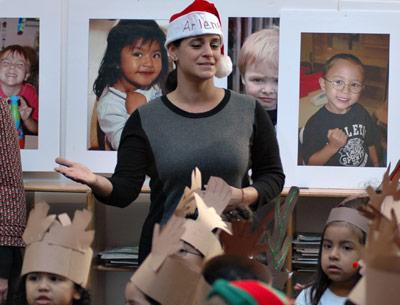Learning Center Relies on Fund-Raising

That East Hampton is changing is evident at the Eleanor Whitmore Early Childhood Center on Gingerbread Lane Extension in East Hampton, where 110 children between the ages of 18 months and 5 years are offered day care and prekindergarten classes.
Early on a recent Tuesday morning, a group of 17 4-year-olds sat in a half circle as their teacher, Arlene Notel, read aloud from “What the Sun Sees, What the Moon Sees.” While the class is not designated as bilingual, Ms. Notel alternates between English and Spanish, whether describing the sun and the moon or counting the days of the month. “The majority are bilingual,” she said.
After circle time, the children ate snacks, either provided by the school or brought from home, everything from pretzels to orange slices to canned peaches.
The East Hampton Day Care Learning Center changed its name to the Eleanor Whitmore Early Childhood Center two months ago, honoring a longtime benefactor who is now its honorary president. Maureen Wikane, who has been its executive director for 16 years, said the name change was also intended to help spread the word that the center offers more than day care.
New York State has recommended universal pre-K for 4-year-olds but has not provided any funding. The East Hampton School District’s half-day program for 4-year-olds is provided at the center free of charge. Most other South Fork districts offer half-day prekindergarten programs, as well. Bridgehampton and Amagansett offer full-day pre-K for both 3-year-olds and 4-year-olds, and Montauk offers a full-day program for 4-year-olds.
At the Early Childhood Center, parents have an option to pay for an extended-day program for prekindergartners. The center also has fee-based full-day programs for 3-year-olds and toddlers.
Were financing not a constant worry, Ms. Wikane would like the 4-year-old program to be full-day and also to provide full-day 3-year-old pre-K at the center. Of the Early Childhood Center’s $1.3 million annual budget, Ms. Wikane and the 11-member board of directors are tasked with raising $350,000 each year — and that’s just to make ends meet.
Raising money from second homeowners poses a challenge, Ms. Wikane said, although some, like the actor Alec Baldwin, have been significant donors. The center also benefits from book fairs and from its annual holiday party and silent auction at the Palm restaurant in East Hampton. It was reported that local businesses were particularly generous in providing raffle prizes when the party was held on Dec. 8 this year.
Ms. Wikane said the center subsidizes every child in order to keep parents’ costs down. Parents whose children are not in prekindergarten pay $250 a week for five full days of child care, including breakfast, lunch, and two snacks. The toddler program has a waiting list, with some parents waiting as long as six months to secure a spot, Ms. Wikane said.
Ms. Notel has taught pre-K for 11 years. Having studied Spanish in college, she said she became more fluent on the job, particularly in the past decade as the number of students speaking Spanish at home increased. “Although I want them to be engaged and speaking their native language, the goal is for them to learn English.”
She teaches two pre-K sections, one from 8:30 to 11:15 a.m., the other from 12:30 to 3:15 p.m. If the program were not highly subsidized with a combination of state, local, and private funds, she believes several children would not be able to attend.
In recent years, awareness of the importance of early childhood education has grown, with particular emphasis on the years before a child is old enough for kindergarten. Dana Friedman, president of the Early Years Institute, a Plainview nonprofit that works with early childhood programs across Long Island, sees the need for intervention for children whose families have few resources as particularly acute.
“When poor children are in high-quality programs, they arrive at school better prepared and require less remediation, and in 40 years are more likely to have a family, a home, and a job,” she said. “You can either pay now, or pay later.” Ms. Friedman said that, while 85 percent of brain growth occurs during the first five years of life, 90 percent of money for education is spent on the years after that.
“The research is saying they need the full day and they’re ready for it,” Ms. Wikane said, noting that transportation is a particular burden for working parents who are asked to collect their children midday or pay to have them continue in the center’s extended-day program.
Unlike many programs in other local districts, the Early Childhood Center provides services year-round, which is a benefit to those parents who work a lot more in summer. The center fills a vital need for families in which both parents work, she said. Its doors are open from 7:30 a.m. to 5:30 p.m. each day.
“The bank people, the grocery store workers, the landscapers — without their children being taken care of, they couldn’t do their jobs,” she said.
Alexandra McCourt is one such parent. Her son, Stefano, 22 months, started the toddler program this year. Ms. McCourt is an English as a second language teacher at the John M. Marshall Elementary School, a short walk from the Early Childhood Center.
She and her husband, who works as a waiter, are raising their son in a bilingual, Spanish and English, home. Mostly, she sees the availability of high-quality day care as a huge relief, enabling her to be in the full-time workforce, while also knowing her child is safe and happy and served nutritious meals. Since becoming a mother, finding consistent child care has proved burdensome. “We don’t have any family here. It’s been really tough,” Ms. McCourt said. “He loves going there. He’s so happy. They all know his name.”
